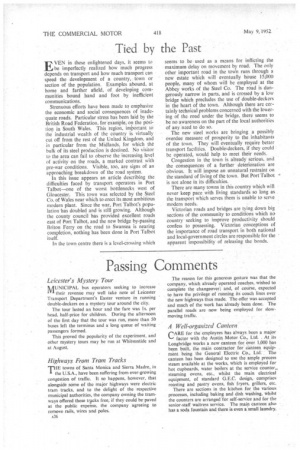Tied by the Past
Page 28

If you've noticed an error in this article please click here to report it so we can fix it.
EVEN in these enlightened days, it seems to be imperfectly realized how much progress depends on transport and how much transport can speed the development of a country, town or section of the population. Examples abound, at home and farther afield, of developing communities bound hand and foot by inefficient communications.
Strenuous efforts have been made to emphasize the economic and social consequences of inadequate roads. Particular stress has been laid by the British Road Federation. for example, on the position in South Wales. This region, imkortant to the industrial wealth of the country is virtually cut off from the rest of the United Kingdom, and in particular from the Midlands, for which the bulk of its steel production is destined. No visitor to the area can fail to observe the increasing level of activity on the roads, a marked contrast with pre-war -conditions. Visible, too, are signs of an approaching breakdown of the road system.
In this issue appears an article describing the difficulties faced by transport operators in Port Talbot—one of the worst bottlenecks west of Gloucester. This town was selected by the Steel Co. of Wales near which to erect its most ambitious modern plant. Since the war. Port Talbot's population has doubled and is still growing. Although the county council has provided excellent roads east of Port Talbot, and the new bridge by-passing Briton Ferry on the road to Swansea is nearing completion, nothing has been done in Port Talbot itself.
In the town centre there is a level-crossing which seems to be used as a means for inflicting the maximum delay on movement by road. The only other important road in the tow'n runs through a new estate which will eventually house 15,000 people, many of whom will be employed at the Abbey works of the Steel Co. The road is dangerously narrow in parts, and is crossed by a low bridge which precludes the use of double-deckers in the heart of the town. Although there are certainly technical problems concerned with the lowering of the road under the bridge, there seems to be no awareness on the part of the local authorities of any need to do so.
The new steel works are bringing a possibly overdue measure of prosperity to the inhabitants of the town. They will eventually require better transport facilities. Double-deckers, if they could be operated, would help to meet their needs.
Congestion in the town is already serious, and the consequences of a further deterioration are obvious. It will impose an unnatural restraint on the standard of living of the town. But Port Talbot is not alone in its difficulties.
There are many towns in this country which will never keep pace with living standards so long as the transport which serves them is unable to serve modern needs.
Victorian roads and bridges are tying down big sections of the community to conditions which no country seeking to improve productivity should confess to possessing. Victorian conceptions of the importance of road transport in both national and local-government circles are responsible for the apparent impossibility of releasing the bonds.




















































































